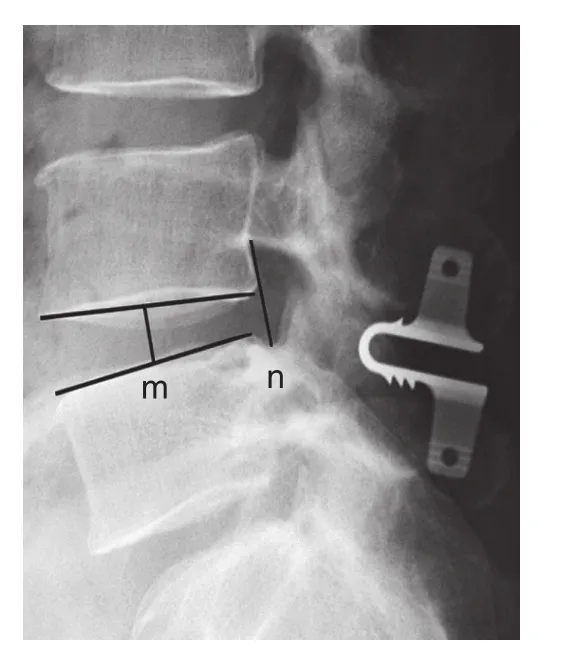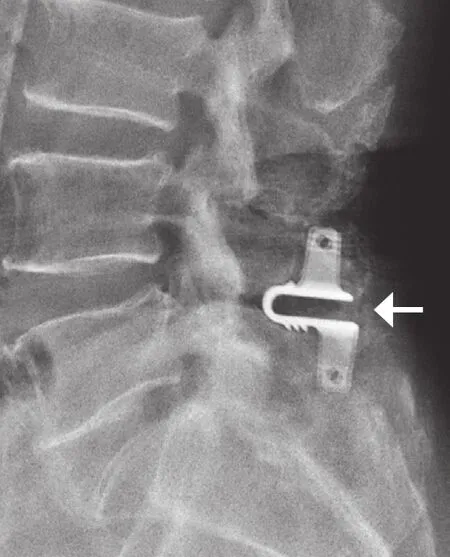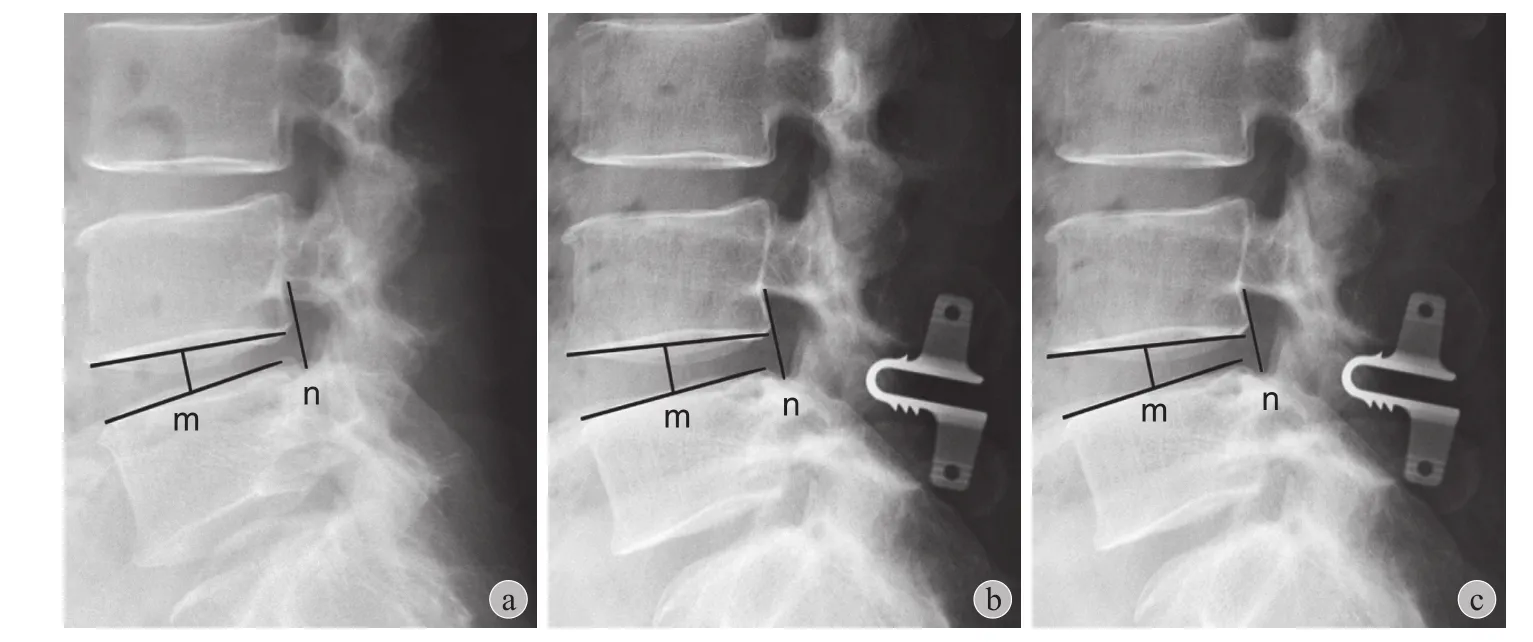棘突间动态稳定术治疗腰椎管狭窄症的长期随访研究
2018-03-01潘爱星海涌杨晋才苏庆军关立康南刘玉增孟祥龙张扬璞
潘爱星 海涌 杨晋才 苏庆军 关立 康南 刘玉增 孟祥龙 张扬璞
腰椎减压融合术是目前腰椎退行性疾病的主要外科治疗方式[1]。腰椎融合的主要适应证为腰椎退行性失稳或医源性不稳[2]。腰椎融合术的临床疗效获得了长期验证并在临床中得到广泛应用,但是其并发症也不容忽视,如假关节形成、内固定失败和邻近节段退变 ( adjacent segment degeneration,ASD )等[3]。为了避免腰椎融合术相关并发症,腰椎非融合技术应运而生[4]。腰椎非融合技术主要分为三大类:人工椎间盘,经椎弓根动态内固定 ( Dynesys )和棘突间动态内固定[5-8]。
腰椎棘突间动态内固定系列主要有:X-stop、Wallis、DIAM 和 Coflex。Coflex 也称为棘突间 U 形内固定,能在维持稳定的同时允许腰椎节段在屈伸方向均保留一定活动度,在临床中应用较为广泛。Coflex 动态稳定能在腰椎减压后维持其运动节段稳定性、增加椎间孔高度 ( intervertebral foraminal height,IFH ) 和减轻小关节负荷[9]。腰椎减压联合Coflex 棘突间动态稳定术治疗腰椎管狭窄症在众多研究中均获得良好临床疗效[10-11]。在多节段腰椎管狭窄症的手术治疗中,对于椎管狭窄程度较轻的近端节段可应用 Coflex 动态稳定与远端融合相结合,称为 Topping-off 术,借此能够保留更多的腰椎活动度 ( lumbar range of motion,ROM ),同时 Coflex 避免了手术与非手术节段应力集中,理论上能预防ASD[12]。2007 年 9 月至 2009 年 6 月,我院采用腰椎减压 ( 融合或无融合 ) 联合 Coflex 棘突间动态稳定手术治疗 30 例腰椎管狭窄症患者,对 Coflex 棘突间动态稳定术治疗腰椎管狭窄症的长期临床疗效和影像学变化进行分析,报告如下。
资料与方法
一、纳入与排除标准
1. 纳入标准:( 1 ) 明确诊断为腰椎管狭窄症者;( 2 ) 无腰椎滑脱或 I 度以内稳定滑脱者;( 3 ) 保守治疗无效者;( 4 ) Coflex 术后完整、规律随访 7 年以上者。
2. 排除标准:( 1 ) 既往有腰椎手术史者;( 2 ) 峡部裂型腰椎滑脱或 II 度以上腰椎滑脱者;( 3 ) 合并腰椎创伤、感染或肿瘤者。
二、一般资料
本组共纳入 30 例,其中男 12 例,女 18 例;年龄 46~77 岁,平均 ( 64.83±11.83 ) 岁。本组 30 例中 25 例行腰椎单节段减压 Coflex 棘突间动态稳定植入术 ( Coflex 组 ),5 例行腰椎后路减压椎间融合联合上位邻近节段 Coflex 动态稳定术 ( Topping-off 组 )。
三、手术技术
患者全麻,俯卧位。取腰椎正中切口,骨膜下剥离椎旁肌肉,保留棘上韧带。切除狭窄节段棘间韧带和黄韧带,咬除部分椎板进行椎管减压,必要时进行神经根管潜行减压,减压时保留关节突关节的完整性。椎管减压后可见硬膜及行走神经根无受压。应用试模选择合适型号 Coflex,植入 Coflex 后加压双侧尾翼,缝合棘上韧带。常规放置伤口引流,关闭伤口。对于 Topping-off 手术,则先于狭窄节段行后路开窗减压椎间融合术,后于邻近节段按上述步骤植入 Coflex。
四、临床及影像学评估
临床评估内容包括:术前、术后及随访时腰痛及下肢疼痛视觉模拟评分 ( visual analogue scale,VAS ),Owestry 功能障碍指数 ( owestry disability index,ODI )。同时,记录手术相关并发症,再手术率,ASD 发生率。ASD 的影像学诊断标准为:( 1 )椎间隙高度 ( intervertebral space height,ISH ) 下降50%[13];( 2 ) 矢状面相邻椎体滑移 ≥ 4 mm[13];( 3 )椎间活动度>10°[14]。ASD 的临床诊断标准为:患者符合影像学表现的同时出现腰椎管狭窄症状,如腰部疼痛和 ( 或 ) 下肢放射痛,伴 ( 或不伴 ) 神经源性间歇性跛行[15-16]。
影像学评估包括:手术节段及其邻近节段IFH、ISH 和 ROM。IFH 及 ISH 测量方式见图 1,ROM 定义为在过屈过伸位 X 线片上 L1~S1矢状面Cobb’s 角的变化范围。
五、统计学处理
采用 SPSS 23.0 软件进行统计学分析。计量资料以±s 表示,术前、术后及随访时计量资料应用配对样本 t 检验进行分析,不符合正态分布数据进行秩和检验。P<0.05 为差异有统计学意义。
结 果
本组随访时间 84~108 个月,平均 94.6 个月。两组患者手术节段分布详见表 1。Coflex 组手术时间平均为 ( 76.5±12.6 ) min,Topping-off 组平均手术时间为 ( 120.8±17.5 ) min;前者术中平均出血量为( 150.7±24.8 ) ml,明显少于后者 ( 280.1±30.1 ) ml,差异有统计学意义 ( P<0.001 )。两组平均住院天数分别为 ( 10.8±1.9 ) 天和 ( 12.5±1.5 ) 天 ( 表 2 ),差异有统计学意义 ( P<0.001 )。在临床症状评估方面,所有患者的腰痛与腿痛 VAS 和 ODI 评分在末次随访时均获得显著改善,差异有统计学意义 ( P<0.05 ) ( 表 3 )。Coflex 节段的 ROM 末次随访较术前减小,差异有统计学意义 ( P<0.05 );Coflex 上下邻近节段的 ROM 末次随访与术前比较,差异无统计学意义 ( P>0.05 ) ( 表 4 )。
IFH 与 ISH 的变化趋势相同,Coflex 及其邻近节段 IFH 在术后短期升高 ( P<0.05 )。在末次随访时IFH 恢复至术前水平 ( P>0.05 ) ( 表 5、6,图 2、3 )。

图1 IFH 及 ISH 测量方式 ( m:ISH,定义为上下终板中点的距离;n:IFH,定义为与 m 平行的在椎间孔内的最大长度 )Fig.1 Measurement of intervertebral space height ( ISH ) and intervertebral foraminal height ( IFH ) ( m: ISH was defined as the length between the two midpoints of endplates; n: IFH was defined as the longest length in the foramen parallel to “m” )

表1 患者一般资料及临床评估Tab.1 Demographic data and perioperative data.
表2 手术时间、出血量及住院时间两组比较 ( ±s )Tab.2 Perioperative data ( ±s )

表2 手术时间、出血量及住院时间两组比较 ( ±s )Tab.2 Perioperative data ( ±s )
项目 Coflex 组 Topping-off 组 P 值手术时间 ( min ) 76.5±12.6 ( 60~126 ) 120.8±17.5 ( 100~180 ) < 0.001出血量 ( ml ) 150.7±24.8 ( 100~200 ) 280.1±30.1 ( 180~400 ) < 0.001住院时间 ( 天 ) 10.8± 1.9 ( 8~ 14 ) 12.5± 1.5 ( 10~ 16 ) < 0.001
表3 临床评估 ( ±s )Tab.3 Clinical evaluation ( ±s )

表3 临床评估 ( ±s )Tab.3 Clinical evaluation ( ±s )
时间 VAS ( 腰痛 ) VAS ( 腿痛 ) ODI术前 6.87±1.53 7.81±1.49 54.2±16.39末次随访 2.13±0.78 2.08±0.83 8.87± 2.86 P 值 0.000 0.000 0.000
表4 腰椎 ROM ( ±s,° )Tab.4 Range of motion ( ±s, ° )

表4 腰椎 ROM ( ±s,° )Tab.4 Range of motion ( ±s, ° )
时间 Coflex 节段 Coflex 上邻近节段 Coflex 下邻近节段术前 5.70±3.69 5.21±3.06 4.62±2.66末次随访 3.04±2.31 4.13±2.01 3.94±2.47 P 值 0.001 0.090 0.366
在长期随访过程中,4 例 ( 13.3% ) 出现 Coflex假体周围骨溶解 ( 图 4 ),2 例 ( 6.7% ) 出现假体周围异位骨化 ( 图 5 )。ASD 3 例,手术节段腰椎管再狭窄 1 例,其它节段狭窄 1 例,其中 4 例( 13.3% ) 行二次手术。无 Coflex 假体骨折或脱位,无棘突骨折。围术期未出现感染、血肿及神经损伤等并发症。
典型病例:患者,女,51 岁,诊断:L4~5腰椎管狭窄症,行 L4~5椎管减压棘突间 Coflex 内固定术( 图 6 )。
表5 ISH 变化 ( ±s,mm )Tab.5 Intervertebral space height ( ±s, mm )

表5 ISH 变化 ( ±s,mm )Tab.5 Intervertebral space height ( ±s, mm )
注:P12 值:术前与术后相比;P13 值:术前与末次随访相比;P23 值:术后与末次随访相比Notice: P12: P value comparing pre-operation and post-operation; P13: P value comparing pre-operation and the last follow up; P23: P value comparing postoperation and the last follow up
时间 Coflex 节段 Coflex 上邻近节段 Coflex 下邻近节段术前 9.96±1.82 9.98±1.67 11.95±1.92术后 12.00±2.06 11.56±1.67 14.01±2.64末次随访 9.19±2.17 9.60±2.17 12.08±2.33 P12 值 0.000 0.000 0.000 P13 值 0.075 0.260 0.697 P23 值 0.000 0.000 0.000
表6 IFH 变化 ( ±s,mm )Tab.6 Intervertebral foramen height ( ±s, mm )

表6 IFH 变化 ( ±s,mm )Tab.6 Intervertebral foramen height ( ±s, mm )
注:P12 值:术前与术后相比;P12 值:术前与末次随访相比;P23值:术后与末次随访相比Notice: P12: P value comparing pre-operation and post-operation; P12:P value comparing pre-operation and the last follow up; P23: P value comparing post-operation and the last follow up
时间 Coflex 节段 Coflex 上邻近节段 Coflex 下邻近节段术前 19.41±1.74 20.63±2.07 17.06±2.13术后 22.14±2.39 23.76±2.66 18.44±2.16末次随访 19.52±2.87 20.80±2.53 16.60±2.43 P12 值 0.000 0.000 0.001 P12 值 0.826 0.705 0.362 P23 值 0.000 0.000 0.001

图2 Coflex 节段及其邻近节段 ISH 变化Fig.2 Intervertebral space height of the Coflex segment and adjacent segments

图3 Coflex 节段及其邻近节段 IFH 变化Fig.3 Intervertebral foramen height of the Coflex segment and adjacent segments

图4 在 Coflex 假体与棘突之间可见骨溶解现象 ( 箭头所示 )Fig.4 Bone erosion could be seen at the Coflex-spinous process interface ( arrows )

图5 在 Coflex 假体周围可见异位骨化形成 ( 箭头所示 )Fig.5 Heterotopic ossification could be seen around the Coflex device ( arrow )
讨 论
自从 Fred L. Knowles 在 20 世纪 50 年代首次发明一种名为“Plug”的棘突间内固定,越来越多的棘突间固定装置逐渐被发明上市[17]。Coflex 棘突间动态稳定装置是由 Jacques Samani 在 1994 年首次提出,也曾被称为棘突间 U 形内固定。棘突间植入Coflex 能撑开脊柱后柱结构,扩大 IFH,减小小关节负重,同时稳定腰椎节段。

图6 a:术前侧位腰椎 X 线片( m = 10.03 mm,n = 19.66 mm );b:术后侧位腰椎 X 线片 ( m =11.89 mm,n = 20.75 mm );c:术后 7 年随访侧位腰椎 X 线片 ( m =9.81 mm,n = 19.48 mm )。m:ISH,n:IFHFig.6 a: Pre-operation lateral X-ray film ( m = 10.03 mm, n =19.66 mm ); b: Post-operation lateral X-ray film ( m = 11.89 mm,n = 20.75 mm ); c: 7-year followup lateral X-ray film ( m = 9.81 mm,n = 19.48 mm ). m: ISH. n: IFH
Coflex 棘突间动态稳定术的适应证有:单节段或双节段腰椎管狭窄症;I 度以内稳定的腰椎滑脱症;椎间盘源性腰痛;小关节紊乱综合征等。对于多节段腰椎管狭窄症患者,可采用融合联合 Coflex这种“动-静结合”的手术方案,被称为 Toppingoff 手术。这种术式能够在完成椎管减压的同时尽量减少腰椎融合节段数,而且能够避免融合的近端应力集中,预防 ASD 的发生[12,18]。由于 S1棘突较小,Coflex 一般不适用与植入 L5~S1节段。
目前,已有许多文献报道 Coflex 棘突间动态稳定术治疗腰椎管狭窄症能够取得中短期较理想的临床疗效[11,19],但缺少长期临床疗效的报道。本中心于 2007 年在中国率先将 Coflex 棘突间动态稳定技术应用于临床,目前已完成 300 余例 Coflex 手术。本研究总结分析了 Coflex 棘突间动态稳定手术的7 年以上长期随访结果,能够更好地指导其在临床的开展。
本研究中所有患者均获得较好的症状改善。在影像学方面,IFH 和 ISH 在术后短期得益于 Coflex的撑开作用获得一定程度的提升,但在长期随访中逐渐下降至术前水平。Trautwein 等[20]认为 Coflex植入增加 IFH 后实现神经根减压是患者获得症状改善的主要原因。但是本研究中,患者的临床症状改善程度并未因 IFH 的丢失而下降。Sobottke 等[21]的研究同样分析了临床疗效与影像学变化之间的相关性,结论与本研究一致。
与单纯减压治疗腰椎管狭窄症相比,减压联合Coflex 植入能够获得更好的临床疗效。Kumar 等[22]进行了一项为期 2 年的前瞻性队列研究,对比了单纯减压和减压联合 Coflex 植入两组病例,研究结果表明两组患者均能获得临床症状改善,但是后者在各随访时间点的临床疗效均优于前者。传统融合术一直以来是治疗腰椎管狭窄症的主要手术方式[23-24]。与融合术相比,Coflex 动态稳定亦能体现出其优势。笔者对单纯行减压联合 Coflex 植入与单节段后路减压融合术治疗腰椎管狭窄症进行了 5 年以上对比研究,结果表明,单纯行减压联合 Coflex植入能够在获得与融合术相同临床疗效,同时能够保留腰椎 ROM,减少 ASD 的发生[10]。Bae 等[19]在2016 年进行的一项前瞻性随机对照研究,对比了196 例 Coflex 手术和 94 例融合手术治疗腰椎管狭窄症,同样证实了 Coflex 能够达到与融合术相当的临床疗效。
与传统腰椎手术一样,Coflex 棘突间动态稳定手术的围术期并发症不容忽视,如神经损伤、伤口感染和心脑血管系统并发症等。与 Coflex 相关的并发症有棘突骨折、假体翼断裂[25]、异位骨化[26]、骨溶解和假体移位。为了减少 Coflex 相关并发症,Zang 等[27]认为在以下情况应谨慎选择 Coflex 植入:严重骨质疏松患者、棘突间隙狭窄、手术节段冠状面侧方滑移或矢状面失稳。本研究中 4 例出现假体周围骨溶解,但无明显假体移位,患者未诉腰部疼痛等不适。当患者出现有症状的棘突骨折或假体移位则需要进行翻修手术取出内固定。
在远期并发症 ASD 方面,与融合术相比 Coflex也有一定的优势。周盛源等[28]认为在腰椎融合节段相邻退变节段棘突间置入 Coflex 动态稳定装置具有预防邻近腰椎节段退变的作用。Pan 等[29]的一项Meta 分析对比了腰椎融合术与非融合术后 ASD 的发生率,结果表明,腰椎非融合术能够显著降低邻近腰椎节段退变的发生。本研究中 3 例 ( 10% ) 出现邻近腰椎节段退变,其中 2 例因保守治疗无效行二次手术治疗,另有 2 例因 Coflex 手术节段再狭窄和非邻近节段退变行二次手术。
本研究的不足亦不容忽视。首先,本研究所纳入患者数较少,且均来自单中心;其次,本研究未对 Coflex 棘突间动态稳定术和融合术进行对比。但是在随访周期上,本研究是目前为止对 Coflex 临床应用最长时间的报道。
总之,通过对腰椎管减压联合 Coflex 棘突间动态稳定术治疗腰椎管狭窄症进行的长期随访研究表明,该手术能够取得良好的临床疗效,并发症和再手术率较低。Coflex 能够维持 ISH 和 IFH,保留手术节段腰椎一定的活动度。今后更大样本和更长随访时间的研究将对本技术的应用提供更高质量的参考。
[1] Brantigan JW, Neidre A, Toohey JS. The Lumbar I/F Cage for posterior lumbar interbody fusion with the variable screw placement system: 10-year results of a food and drug administration clinical trial[J]. Spine J, 2004. 4(6):681-688.
[2] Pearson A, Blood E, Lurie J. Predominant leg pain is associated with better surgical outcomes in degenerative spondylolisthesis and spinal stenosis: results from the Spine Patient Outcomes Research Trial (SPORT)[J]. Spine, 2011. 36(3):219-229.
[3] Park P, Garton HJ, Gala VC, et al. Adjacent segment disease after lumbar or lumbosacral fusion: review of the literature[J].Spine, 2004, 29(17):1938-1944.
[4] Gazzeri R, Galarza M, Alfieri A. Controversies about interspinous process devices in the treatment of degenerative lumbar spine diseases: past, present, and future[J]. Biomed Res Int, 2014, 2014:975052.
[5] Denis KL. The interspinous-U: A new restabilization device for the lumbar spine. Spinal Restabilization Procedures[M].Amsterdam: Elsvier. 2002: 355-362.
[6] Stoll TM, Dubois G, Schwarzenbach O. The dynamic neutralization system for the spine: a multi-center study of a novel non-fusion system[J]. Eur Spine J, 2002, 11(Suppl 2):S170-178.
[7] 李利, 史亚民, 郭继东. Dynesys 治疗腰椎退变性疾病的临床疗效[J]. 中国骨与关节杂志, 2013, 2(6):328-331.
[8] Garcia R, Jr, Yue JJ, Blumenthal S, et al. Lumbar Total disc replacement for discogenic low back pain: two-year outcomes of the activl multicenter randomized controlled ide clinical trial[J]. Spine, 2015, 40(24):1873-1881.
[9] 潘爱星, 海涌, 杨晋才, 等. 棘突间 Coflex 动态内固定系统治疗腰椎退行性疾病的影像学研究[J]. 中华外科杂志, 2016,54(7):513-517.
[10] Yuan W, Su QJ, Liu T, et al. Evaluation of Coflex interspinous stabilization following decompression compared with decompression and posterior lumbar interbody fusion for the treatment of lumbar degenerative disease: A minimum 5-year follow-up study[J]. J Clin Neurosci, 2017, 35:24-29.
[11] Park SC, Yoon SH, Hong YP, et al. Minimum 2-year follow-up result of degenerative spinal stenosis treated with interspinous u (coflex)[J]. J Korean Neurosurg Soc, 2009, 46(4):292-299.
[12] Chen XL, Guan L, Liu YZ, et al. Interspinous dynamic stabilization adjacent to fusion versus double-segment fusion for treatment of lumbar degenerative disease with a minimum follow-up of three years[J]. Int Orthop, 2016, 40(6):1275-1283.
[13] Imagama S, Kawakami N, Kanemura T, et al. Radiographic adjacent segment degeneration at five years after L4/5 posterior lumbar interbody fusion with pedicle screw instrumentation:evaluation by computed tomography and annual screening with magnetic resonance imaging[J]. Clin Spine Surg, 2016, 2:2.
[14] Park P, Garton HJ, Gala VC, et al. Adjacent segment disease after lumbar or lumbosacral fusion: review of the literature[J].Spine, 2004, 29(17):1938-1944.
[15] Aota Y, Kumano K, Hirabayashi S. Postfusion instability at the adjacent segments after rigid pedicle screw fixation for degenerative lumbar spinal disorders[J]. J Spinal Disord, 1995,8(6):464-473.
[16] Siewe J, Bredow J, Oppermann J, et al. Evaluation of efficacy of a new hybrid fusion device: a randomized, two-centre controlled trial[J]. BMC Musculoskelet Disord, 2014, 15:294.
[17] Bono CM, Vaccaro AR. Interspinous process devices in the lumbar spine[J]. J Spinal Disord Tech, 2007, 20(3):255-261.
[18] Liu HY, Zhou J, Wang B, et al. Comparison of Toppingoff and posterior lumbar interbody fusion surgery in lumbar degenerative disease: a retrospective study[J]. Chin Med J(Engl), 2012, 125(22):3942-3946.
[19] Bae HW, Davis RJ, Lauryssen C, et al. Three-year followup of the prospective, randomized, controlled trial of Coflex interlaminar stabilization vs instrumented fusion in patients with lumbar stenosis[J]. Neurosurgery, 2016, 79(2):169-181.
[20] Trautwein FT, Lowery GL, Wharton ND, et al. Determination of the in vivo posterior loading environment of the Coflex interlaminar-interspinous implant[J]. Spine J, 2010, 10(3):244-251.
[21] Sobottke R, Schluter-Brust K, Kaulhausen T, et al. Interspinous implants (X Stop, Wallis, Diam) for the treatment of LSS: is there a correlation between radiological parameters and clinical outcome[J]? Eur Spine J, 2009, 18(10):1494-1503.
[22] Kumar N, Shah SM, Ng YH, et al. Role of coflex as an adjunct to decompression for symptomatic lumbar spinal stenosis[J].Asian Spine J, 2014, 8(2):161-169.
[23] Booth KC, Bridwell KH, Eisenberg BA, et al. Minimum 5-year results of degenerative spondylolisthesis treated with decompression and instrumented posterior fusion[J]. Spine,1999, 24(16):1721-1727.
[24] Andersen T, Videbaek TS, Hansen ES, et al. The positive effect of posterolateral lumbar spinal fusion is preserved at long-term follow-up: a RCT with 11-13 year follow-up[J]. Eur Spine J,2008, 17(2):272-280.
[25] Xu C, Ni WF, Tian NF, et al. Complications in degenerative lumbar disease treated with a dynamic interspinous spacer(Coflex)[J]. Int Orthop, 2013, 37(11):2199-2204.
[26] Tian NF, Wu AM, Wu LJ, et al. Incidence of heterotopic ossification after implantation of interspinous process devices[J]. Neurosurg Focus, 2013, 35(2):E3.
[27] Zang L, DU P, Hai Y, et al. Device related complications of the Coflex interspinous process implant for the lumbar spine[J].Chin Med J, 2013, 126(13):2517-2522.
[28] 周盛源, 陈雄生, 贾连顺. 棘突间动态稳定装置 Coflex 预防腰椎融合术后相邻节段退变的短期随访疗效观察[J]. 中华外科杂志, 2012, 50(9):772-775.
[29] Pan A, Hai Y, Yang J, et al. Adjacent segment degeneration after lumbar spinal fusion compared with motion-preservation procedures: a meta-analysis[J]. Eur Spine J, 2016, 25(5):1522-1532.
